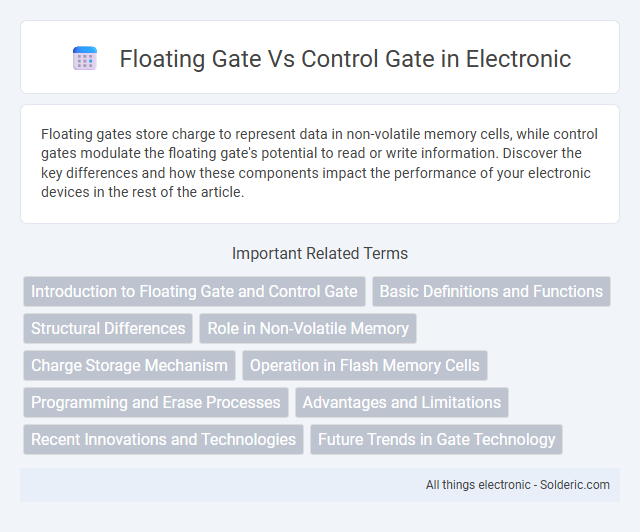Floating gates store charge to represent data in non-volatile memory cells, while control gates modulate the floating gate's potential to read or write information. Discover the key differences and how these components impact the performance of your electronic devices in the rest of the article.
Comparison Table
| Feature | Floating Gate | Control Gate |
|---|---|---|
| Definition | Conductive gate isolated by oxide, stores charge for memory retention | Main gate controlling transistor channel, interfaces with external circuitry |
| Function | Stores electrons to retain data in non-volatile memory (e.g., EEPROM, Flash) | Applies voltage to modulate channel conductivity and control transistor operation |
| Charge Storage | Holds charge trapped in dielectric layer | Does not store charge, only controls electrical signals |
| Location | Embedded within oxide layers between control gate and substrate | Located above floating gate, separated by insulating oxide |
| Role in Memory | Key element for data retention in flash memory cells | Enables programming and erasing through voltage control |
| Material | Usually polysilicon or metal | Typically polysilicon or metal |
Introduction to Floating Gate and Control Gate
Floating gates and control gates are essential components of non-volatile memory cells, crucial for data storage in flash memory devices. The floating gate stores electrical charge, enabling the retention of binary information without power, while the control gate regulates the flow of electrons to and from the floating gate through a thin insulating layer. Understanding the distinct roles of floating gates and control gates is fundamental for optimizing memory cell design, enhancing data retention, and improving write/erase cycle performance in semiconductor technology.
Basic Definitions and Functions
The floating gate is a layer of conductive material within a transistor that stores electrical charge, enabling non-volatile memory functions essential in flash memory devices. The control gate, positioned above the floating gate, regulates the flow of electrons to and from the floating gate during programming and erasing operations. Together, the floating gate and control gate manage the data storage process by controlling the transistor's threshold voltage, impacting memory cell states.
Structural Differences
Floating Gate and Control Gate differ primarily in their structural roles within a transistor. The Floating Gate is a fully insulated layer of polysilicon, surrounded by an oxide layer, designed to trap and store electrons, enabling non-volatile memory functions. Your memory cell's Control Gate, positioned above the Floating Gate with its own oxide insulation, modulates the transistor channel conductivity by applying voltage, influencing data read and write operations.
Role in Non-Volatile Memory
Floating gates store electrical charge to retain data even when power is off, enabling non-volatile memory functionality. Control gates regulate the programming and erasing processes by applying voltage to influence the charge on the floating gate. Understanding the interaction between these gates helps optimize your memory device's performance and data retention reliability.
Charge Storage Mechanism
The floating gate stores charge by trapping electrons within a conductive polysilicon layer isolated by an oxide, enabling non-volatile memory retention. The control gate modulates the charge flow into and out of the floating gate through capacitive coupling without directly storing charge. This separation allows effective programming and erasing of data in flash memory devices.
Operation in Flash Memory Cells
Floating gate and control gate are critical components in flash memory cells that enable data storage through charge trapping. The floating gate, insulated by oxide layers, stores electrons injected during programming, altering the threshold voltage of the cell, while the control gate modulates this charge by applying voltage to read or write data. Efficient operation relies on Fowler-Nordheim tunneling or hot-electron injection mechanisms to move charges between the floating gate and the substrate, facilitating non-volatile memory retention.
Programming and Erase Processes
The Floating Gate stores electrical charge to represent data in non-volatile memory, enabling programming by injecting electrons through Fowler-Nordheim tunneling or hot-electron injection, while erasing involves removing electrons to reset the charge state. The Control Gate modulates the channel conductivity by controlling the voltage applied, playing a crucial role in both programming and erase cycles by influencing the electron tunneling process. Your device's memory reliability and speed depend heavily on the precise interaction between the Floating Gate and Control Gate during these processes.
Advantages and Limitations
Floating gate technology offers non-volatile data storage with high endurance and low power consumption, making it ideal for EEPROM and flash memory devices. Control gate enables precise programming and erasing by modulating the charge on the floating gate, enhancing data retention and reliability. Limitations include complexity in fabrication and susceptibility to charge leakage over time, which can impact long-term data stability.
Recent Innovations and Technologies
Recent innovations in floating gate and control gate technologies have significantly enhanced data storage capabilities in non-volatile memory devices, particularly NAND flash memory. Advanced materials like high-k dielectrics and novel 3D NAND architectures improve charge retention and reduce leakage in floating gates, while precision control gate engineering enables faster programming speeds and lower power consumption. Emerging techniques such as charge trap memory and silicon-oxide-nitride-oxide-silicon (SONOS) structures further optimize the interaction between floating and control gates, boosting memory density and device reliability.
Future Trends in Gate Technology
Future trends in gate technology emphasize the integration of floating gates with advanced materials like high-k dielectrics to enhance charge retention and scalability in non-volatile memory devices. Emerging control gate designs incorporate two-dimensional materials such as graphene to improve electrical conductivity and reduce power consumption in next-generation semiconductor applications. The convergence of novel floating gate architectures and innovative control gate materials is driving the development of faster, more reliable, and energy-efficient memory solutions for artificial intelligence and IoT devices.
Floating Gate vs Control Gate Infographic

 solderic.com
solderic.com